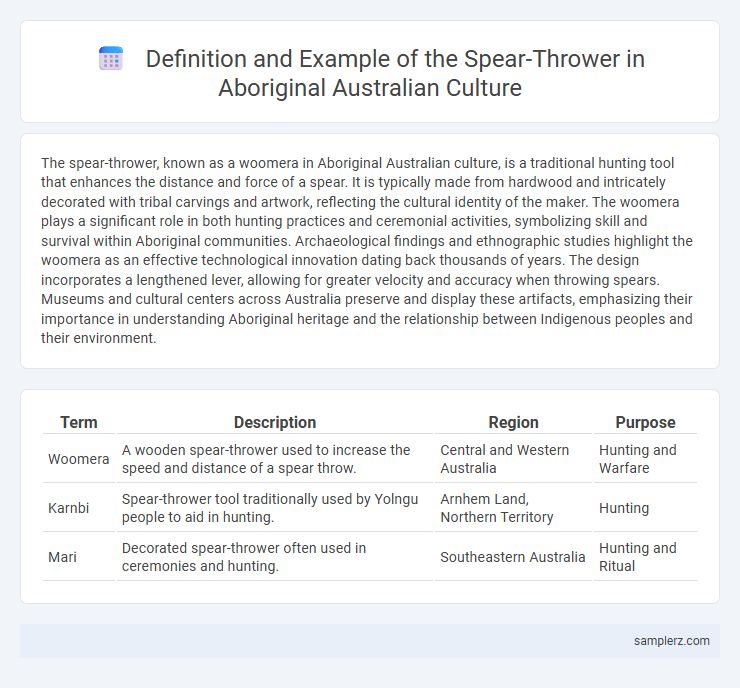The spear-thrower, known as a woomera in Aboriginal Australian culture, is a traditional hunting tool that enhances the distance and force of a spear. It is typically made from hardwood and intricately decorated with tribal carvings and artwork, reflecting the cultural identity of the maker. The woomera plays a significant role in both hunting practices and ceremonial activities, symbolizing skill and survival within Aboriginal communities. Archaeological findings and ethnographic studies highlight the woomera as an effective technological innovation dating back thousands of years. The design incorporates a lengthened lever, allowing for greater velocity and accuracy when throwing spears. Museums and cultural centers across Australia preserve and display these artifacts, emphasizing their importance in understanding Aboriginal heritage and the relationship between Indigenous peoples and their environment.
Table of Comparison
| Term | Description | Region | Purpose |
|---|---|---|---|
| Woomera | A wooden spear-thrower used to increase the speed and distance of a spear throw. | Central and Western Australia | Hunting and Warfare |
| Karnbi | Spear-thrower tool traditionally used by Yolngu people to aid in hunting. | Arnhem Land, Northern Territory | Hunting |
| Mari | Decorated spear-thrower often used in ceremonies and hunting. | Southeastern Australia | Hunting and Ritual |
Historical Significance of Spear-Throwers in Aboriginal Australian Culture
Spear-throwers, also known as woomeras, played a crucial role in Aboriginal Australian culture by enhancing hunting efficiency and enabling long-distance projectile delivery. These tools were intricately crafted from wood and often decorated with clan-specific designs, reflecting both practical use and cultural identity. Historically, woomeras symbolize the deep connection between Aboriginal communities and their land, embodying traditional knowledge and survival skills passed down through generations.
Traditional Crafting Methods of Aboriginal Spear-Throwers
Aboriginal Australian spear-throwers, known as woomeras, exemplify traditional crafting methods that combine functionality with cultural significance. Crafted from hardwoods such as mulga or lancewood, these tools are intricately shaped and smoothed using stone or shell tools, then hollowed to reduce weight without compromising strength. Decorative elements often include engraved patterns and ochre painting, reflecting clan identity and spiritual connection within Aboriginal communities.
Regional Variations: Types of Aboriginal Spear-Throwers
Aboriginal Australian spear-throwers, known as woomeras, exhibit significant regional variations in design, reflecting diverse cultural practices and environmental adaptations. In Central Australia, woomeras are typically long and slender, often intricately carved and decorated with symbols representing Dreamtime stories, while in northern regions, they tend to be shorter and more utilitarian to suit different hunting techniques. These regional differences highlight the rich cultural diversity within Aboriginal communities and their deep connection to land and tradition.
Symbolic Meanings of Spear-Throwers in Indigenous Communities
Spear-throwers in Aboriginal Australian culture serve as symbolic artifacts representing ancestral connections, spiritual beliefs, and traditional hunting practices. These tools often feature intricate designs that convey clan identities, totemic affiliations, and Dreamtime stories integral to Indigenous worldviews. Their ceremonial use reinforces community cohesion and preserves the transmission of cultural knowledge across generations.
Spear-Throwers in Aboriginal Hunting Practices
Spear-throwers, known as woomeras in Aboriginal Australian culture, significantly enhanced hunting efficiency by increasing the speed and distance of spear throws. These wooden tools allowed hunters to target animals from greater ranges, improving success rates in capturing prey such as kangaroos and emus. The woomera's design exemplifies the ingenuity of Aboriginal hunting practices, reflecting deep knowledge of local wildlife behavior and environmental conditions.
Artistic Expressions on Aboriginal Spear-Throwers
Aboriginal Australian spear-throwers, or woomeras, showcase intricate artistic expressions that reflect the rich spiritual beliefs and stories of the community. These tools often feature detailed carvings, painted patterns, and symbolic motifs unique to each Indigenous group, serving both functional and ceremonial purposes. The artistic designs not only enhance the spear-thrower's aesthetic value but also act as a medium for preserving cultural identity and ancestral knowledge.
Spear-Throwers in Ceremonial and Ritual Contexts
Spear-throwers, or woomeras, hold significant ceremonial value in Aboriginal Australian culture, often intricately decorated to represent ancestral stories and clan identity. These ritual objects are used not only as hunting tools but also as sacred items during initiation ceremonies and ceremonial dances. Their designs and craftsmanship symbolize spiritual connection and social status within the Aboriginal communities.
Preservation and Transmission of Spear-Thrower Knowledge
Aboriginal Australian cultures preserve and transmit spear-thrower knowledge through oral traditions and ceremonial practices, ensuring skills and techniques remain intact across generations. The spear-thrower, known as an "woomera," functions not only as a hunting tool but also as a cultural artifact that embodies ancestral wisdom and craftsmanship. Detailed instruction in tool-making and hunting strategies is imparted within kinship groups, reinforcing the cultural significance and practical efficacy of the woomera.
The Role of Elders in Teaching Spear-Thrower Use
Elders in Aboriginal Australian culture play a crucial role in teaching the use of the spear-thrower, or woomera, passing down essential skills and traditional knowledge through generations. Their guidance ensures the precise construction, handling techniques, and spiritual significance of the spear-thrower are preserved within the community. This mentorship not only enhances hunting proficiency but also reinforces cultural identity and continuity.
Contemporary Revitalization of Spear-Thrower Traditions
The contemporary revitalization of spear-thrower traditions in Aboriginal Australian culture is exemplified by artists and communities in Arnhem Land who blend traditional crafting techniques with modern artistic expressions, preserving this ancient practice. Educational programs and cultural workshops actively engage younger generations, fostering a renewed appreciation for spear-thrower craftsmanship as both a functional tool and a cultural symbol. This resurgence highlights the spear-thrower's role in sustaining Indigenous identity and connecting community members to their ancestral heritage.

example of spear-thrower in Aboriginal Australian culture Infographic
 samplerz.com
samplerz.com